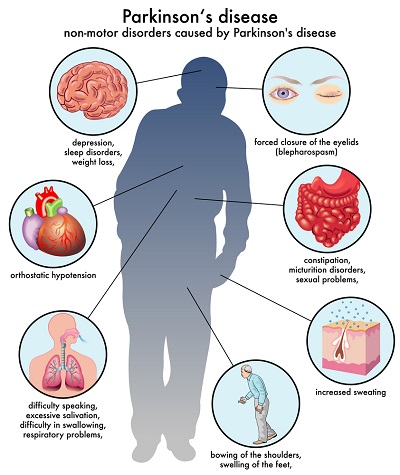 This movement disorder occurs when the brain doesn’t produce sufficient amounts of dopamine. While there are some genetic cases, for the most part, Parkinson’s Disease is not an inherited one. Researchers believe it could be triggered by environmental factors, such as chemical exposure.
This movement disorder occurs when the brain doesn’t produce sufficient amounts of dopamine. While there are some genetic cases, for the most part, Parkinson’s Disease is not an inherited one. Researchers believe it could be triggered by environmental factors, such as chemical exposure.
The Symptoms
The onset of symptoms is gradual. Perhaps the best example of PD is Michael J. Fox who continues to work after his diagnosis, which he disclosed to the public almost two decades ago and the slow decline in his movements.
As per WebMD, the symptoms at the beginning include stiffness in the arms and legs, difficulty with balance and coordination, slower movements, as well as trembling in the legs, hands, arms, and even the face and jaw.
While not everyone will experience the tremors, it is the most common sign of the disease and in the majority of cases; it’s the first to appear. It generally starts in just one limb or area of the body and gradually spreads to other areas. Many people don’t realize that because PD has such an impact on the body’s muscles the effects are widespread.
For instance, it can lead to constipation and even difficulty eating and swallowing. It’s common for PD patients to feel depressed and they will often have difficulty sleeping, too. In the later stages of the disease, the patient may struggle to speak and there is an increased risk of cognitive decline.
The Diagnosis
A diagnosis is always easier when there are simple tests to tell you what the issue is, unfortunately, there is no lab test that can diagnose PD. It is a difficult disease to diagnose and requires doctors looking over a full medical background of the patient, as well as extensive neurological tests. This generally involves testing your range of movement, asking you questions about your history and habits, vision tests, and testing a specific medicine to see how you respond.
The typical age of onset of Parkinson’s Disease is 60 (or older) however, it can strike at any age. Michael J Fox was just 29 when he was diagnosed with PD. Typically, symptoms start appearing after the age of 50. It also affects men at a more alarming rate. The US is home to around a million Parkinson’s patients while there are 10 million PD patients globally.
The Treatment
Parkinson’s Disease has no cure as yet, however, there is a variety of treatments available, which can help patients extend their lifespan and live more comfortably with the disease.
The first step in treating Parkinson’s Disease is taking the relevant medication as prescribed by a medical professional. Then there are the complementary therapies, which include occupational therapy as well as physiotherapy. In some cases, your doctor may recommend brain surgery.
In the earlier stages of the disease, your doctor may not recommend any treatment for you, as the symptoms tend to be incredibly mild. What will be required is regular visits to your medical professional to track your progress so they know what steps to take in the event your condition worsens.
The Outlook
As the disease progresses it may become more difficult to complete normal everyday activities without the help of someone else. For many, the treatment will be sufficient to stave off this situation, however, for some the symptoms worsen to a stage where they become severely disabled.
The good news is that there has been much research into the disease and thanks to the advancements of medical science, the majority of people living with Parkinson’s Disease can expect to live a comfortable and long life, in line with the average life expectancy.






